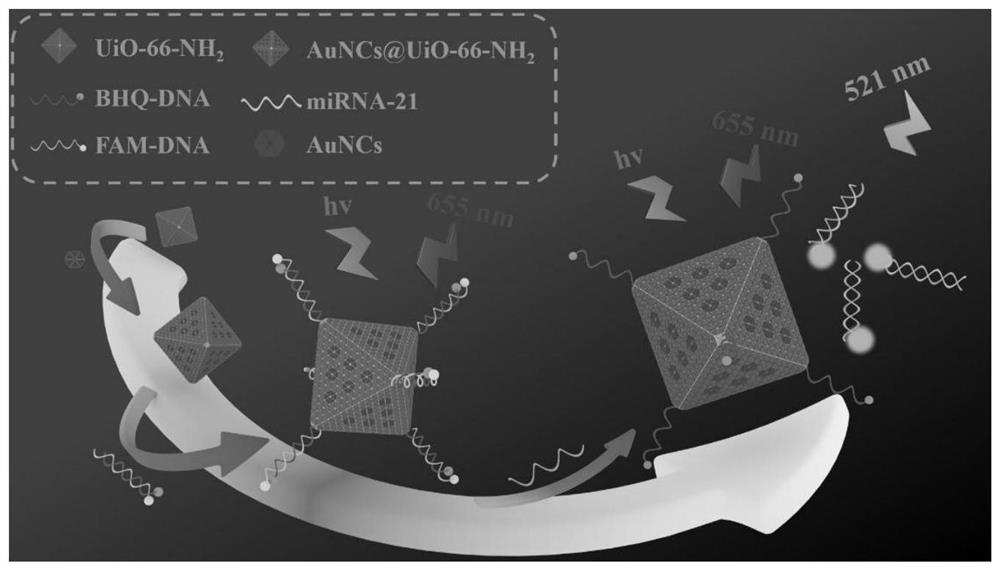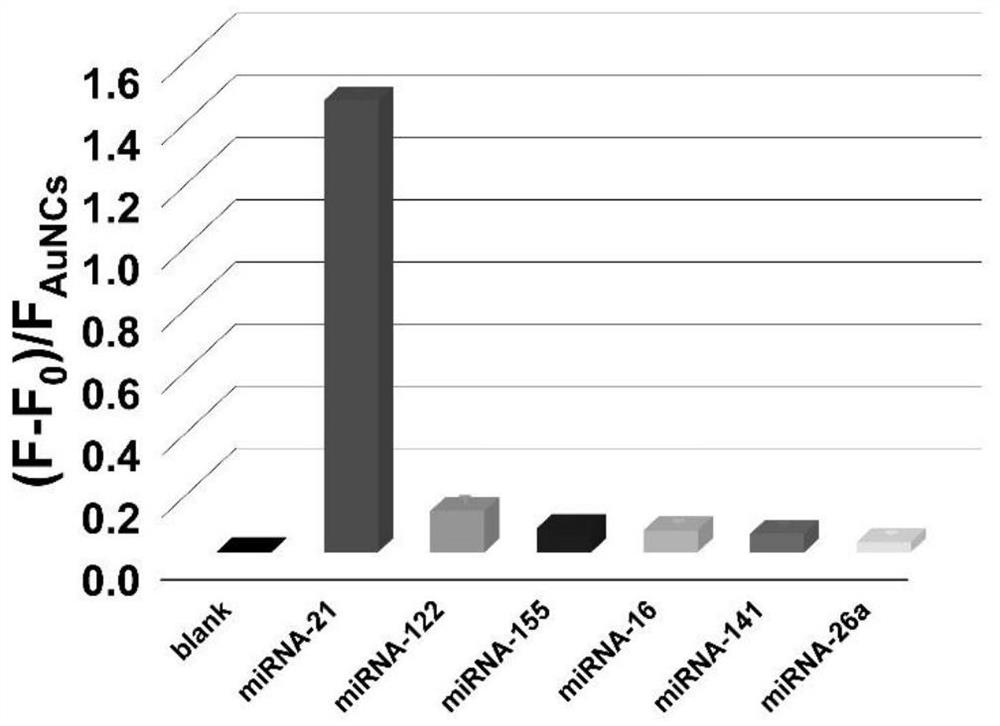Ratio-dependent fluorescent probe and preparation method and application thereof
A fluorescent probe, ratiometric technology, applied in the direction of fluorescence/phosphorescence, chemical instruments and methods, luminescent materials, etc., can solve the problems of long analysis time, low detection sensitivity, complex instruments and equipment, etc., to overcome low sensitivity, biological Good compatibility and high sensitivity detection effect
- Summary
- Abstract
- Description
- Claims
- Application Information
AI Technical Summary
Problems solved by technology
Method used
Image
Examples
Embodiment 1
[0024] A method for preparing a novel metal-organic framework ratiometric fluorescent probe based on loaded gold nanoclusters proposed by the present invention, comprising the steps of:
[0025] (1) Design and synthesize BHQ-DNA1 chain and FAM-DNA2 chain, the sequences from 5' to 3' are: COOH-TCAGACTGATGTTGAA-BHQ1 and 6-FAM-ATCAACATCAGTCTGATAAGCTA, in which, DNA1 chain and DNA2 chain are separated by 3' The 15 bases starting from the 8th base at the end are complementary, and the DNA2 strand is the complementary strand of the target miRNA-21 + A;
[0026] (2) Mix 5.0 μL of BHQ-DNA1 (2.0 μM) and the same amount of FAM-DNA2 (2.0 μM) and then perform annealing treatment, that is, first place the above mixture in a water bath at 90 ° C, gradually cool down to 37 ° C and keep it for 30 min , forming the required double-stranded probe at this time;
[0027] (3) Add 10 mL of deionized water to the mixture of 0.1917 g EDC and 0.1151 g NHS, take 10 μL of this solution and mix with the...
Embodiment 2
[0035] A method for detecting miRNA-21 using the metal-organic framework ratiometric fluorescent probe proposed by the present invention, comprising the steps of:
[0036] (1) Add different concentrations of miRNA-21 (0, 1.0, 2.0, 5.0, 10, 20, 40, 60, 80, 100, 120, 140nM) to 100μL ratiometric fluorescent probe (0.2mg / mL) in solution;
[0037] (2) After incubating at 37°C for 20 minutes, the F-4600 fluorescence spectrometer was used for detection. The specific detection conditions were 488nm as the single excitation wavelength, and the fluorescence intensity of FAM at 521nm and the fluorescence intensity of AuNCs at 655nm were detected respectively, and the slit width was 5.0nm. ;
[0038] (3) Use (F-F 0 ) / F AuNCs As the output signal, F is the fluorescence intensity of the probe at 521nm, F 0 is the blank value at 521nm, F AuNCs is the fluorescence intensity of the probe at 655 nm.
[0039] The experimental results showed that as the concentration of miRNA-21 increased, ...
Embodiment 3
[0041] (1) Human breast cancer MCF-7 cells with high expression of miRNA-21 were selected as the cell model for in situ imaging, and the MCF-7 cells were divided into two groups, one group was treated with 100 μL ratiometric fluorescent probe (0.2 mg / mL) 37°C, 5% CO 2 co-incubated for 2 hours, and the other group was not treated as a blank control;
[0042] (2) Then wash with PBS buffer, and use laser confocal microscope to perform fluorescence imaging on the two groups of cells respectively, and select the excitation wavelength: 488nm;
[0043] The experimental results show that when the ratiometric fluorescent probe enters MCF-7 cells, the intracellular miRNA-21 reacts with the probe, which restores the fluorescent signal of the FAM dye, while the fluorescent signal of AuNCs remains basically unchanged; untreated There is no generation of fluorescent signals in MCF-7 cells. On the one hand, it shows that MCF-7 cells do not generate spontaneous fluorescent signals. On the ot...
PUM
 Login to View More
Login to View More Abstract
Description
Claims
Application Information
 Login to View More
Login to View More - R&D
- Intellectual Property
- Life Sciences
- Materials
- Tech Scout
- Unparalleled Data Quality
- Higher Quality Content
- 60% Fewer Hallucinations
Browse by: Latest US Patents, China's latest patents, Technical Efficacy Thesaurus, Application Domain, Technology Topic, Popular Technical Reports.
© 2025 PatSnap. All rights reserved.Legal|Privacy policy|Modern Slavery Act Transparency Statement|Sitemap|About US| Contact US: help@patsnap.com



